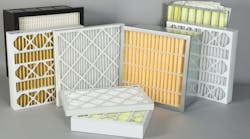Mold. Unless you are a mycologist, the word probably inspires feelings of uncertainty. You may never have experienced a mold problem in your facility, but you certainly have seen the headlines: homes, schools, and other buildings shuttered and deep-cleaned to be rid of the black menace some blame on health issues ranging from mild respiratory problems to debilitating illness.
The issue of “toxic mold” first hit the news during the mid-1990s, with several high-profile cases of severe illness and irreparable building damage. Soon after, the phrase, “Mold is gold,” was coined to reflect the growing industry of mold testing, remediation, and litigation. Since then, untold millions have been spent to rid properties of mold, with millions more paid to claimants for mold-related illnesses and economic losses.
This article will address the issue of mold—specifically, mold spores—as an indoor-air pollutant that can be minimized through an effective HVAC air-filtration strategy.
Mold 101
Molds are fungi found virtually everywhere, most commonly outdoors, in shady, damp areas or places where vegetation is decomposing. Molds propagate by producing—through either active discharge or when disturbed—microscopic (about 2 to 10 microns in diameter) spores. These spores can enter indoor environments through doorways, windows, building holes and cracks, and HVAC systems or attached to people, pets, clothing, and the like.
Small (less than 5 microns) mold spores are likely to be removed by ventilation before settling on surfaces. Large spores, upon settling on surfaces, can mix with other dust and become resuspended in the air as a result of the movement of building occupants.
Although they grow best in warm, damp conditions, molds are resilient, capable of surviving in even the dry conditions found in commercial and institutional buildings.
Some people are more sensitive to molds than others. Effects of mold exposure can range from nasal stuffiness, eye irritation, and wheezing to fever, shortness of breath, and lung infection. Even in otherwise healthy people, mold has been linked to upper-respiratory-tract symptoms and, in the case of children, the development of asthma.
The Role of Air Filtration in Reducing the Spread of Mold Spores
We never can completely rid an indoor environment of mold and mold spores; the best we can hope to do is reduce the growth and spread of mold. To that end, most public-health experts and organizations recommend strategies such as reducing indoor humidity and increasing ventilation. What they often overlook is the role HVAC air filtration can play in trapping and eliminating airborne mold spores.
The key to selecting the right air-filtration strategy for the removal of mold spores from breathing air is matching filter particle-capture efficiency to mold-spore size.
Filter-Selection Strategies
When evaluating filtration efficiency, most professionals turn to minimum efficiency reporting value (MERV). A filter’s MERV—1 is least efficient, 16 is most efficient—is determined by testing according to ANSI/ASHRAE Standard 52.2, Method of Testing General Ventilation Air Cleaning Devices for Removal Efficiency by Particle Size.
When evaluating the results of an ANSI/ASHRAE Standard 52.2 test, facility-maintenance and HVAC professionals are wise to review the fractional-particle-size-vs.-particle-diameter curve included with the test report. The curve provides the efficiency of a filter for a particular particle size: E1 (very fine particles in the 0.3-to-1.0-micrometer range), E2 (fine particles—including smaller mold spores—in the 1.0-to-3.0-micrometer range), and E3 (coarse particles—including larger mold spores—in the 3.0-to-10.0-micrometer range). Filters with high E1 and E2 efficiencies are useful for removing mold spores and critical to providing good indoor-air quality.
Many pleated filters (especially commonly used MERV 8 filters) have very low E1 and E2 efficiencies. In fact, ANSI/ASHRAE Standard 52.2 contains no minimum requirement for capture of E1 particles for filters below MERV 14 and no minimum requirement for capture of E2 particles for filters below MERV 9. Therefore, when specifying filters, be sure to ask suppliers for ANSI/ASHRAE Standard 52.2 test-report data.
When selecting filters, consider those with good balance between mechanical efficiency and electret efficiency (via an electrostatic charge). These filters almost always outperform filters relying solely on mechanical efficiency.
Although submicron particles are much smaller than the void spaces in most commercial electret-charged filter media, the electrostatic forces within the media attract particles with a high degree of efficiency. Electret-charged filter media that provides high filtration efficiency throughout a filter’s life is available.
HVAC and Filter-Maintenance Considerations
The Institute of Medicine (IOM), the World Health Organization, and the National Institute of Occupational Safety & Health (NIOSH) suggest increased attention be paid to building HVAC systems as potential sites for the growth and dispersal of microbial contaminants such as mold. The IOM specifically states bioaerosols from contaminated HVAC systems may be transported to building occupants.
While air filters can remove microorganisms such as mold spores, they also can harbor them, especially if proper maintenance procedures, including regularly scheduled filter changeouts, are not followed. Proper filter maintenance is crucial to keeping HVAC ductwork clean. If dirt accumulates in ductwork and relative humidity reaches the dew point so that condensation occurs, the ductwork can become a breeding ground for bacteria and mold.
NIOSH urges filters be sized and fit into HVAC-system filter racks properly to prevent unfiltered air from entering occupied spaces. NIOSH further recommends filters be replaced regularly.
The Occupational Safety & Health Administration encourages building professionals to check filters for dampness regularly. If a filter is wet or microbial growth can be seen on the media, the filter should be changed immediately. Other maintenance recommendations include:
• Monitor outdoor-air intakes and inlet airways for intrusions of rain, snow, dirt, and leaves.
• Keep air-conditioning drip pans clean and drain lines unobstructed and flowing properly.
• Use sloped drain pans, with drains at the lowest point.
• Use air-conveyance systems with inner surfaces made of materials that are impermeable to water and easy to clean.
• Provide easy access to coils, drain pans, and the downstream side of cooling coils for inspection and cleaning.
The U.S. Environmental Protection Agency (EPA) cautions against running a HVAC system if it is known or suspected to be contaminated with mold. Further, the EPA recommends using “high-quality” air filters and changing them regularly during and following any remediation activity.
Conclusion
Like dust, pollen, and other particulates, mold spores can be carried through indoor air and inhaled by building occupants. Currently, there are no EPA regulations or standards for airborne mold contaminants. This means facility engineers and managers should use filtration efficiency—particularly performance in trapping E1 and E2 particles—to determine an air filter’s ability to remove mold spores. Choosing the right air filter and adhering to sound HVAC maintenance practices are smart measures to take when seeking to protect building occupants from the negative effects of mold.
Remember that even the most efficient filter cannot remove existing mold. Selecting a filter that is highly efficient capturing mold-sized particles, however, may help to prevent the airborne spread of mold spores.
Since joining Kimberly-Clark in 1991, Tony Fedel, PE, has held a variety of positions in sales/business development, operations, research, and engineering. Currently, he is associate marketing director for Kimberly-Clark Professional Partnership Products, which includes roll goods used in protective fabrics, filtration, sorbents, acoustic insulation, medical applications, packaging, and wipes.
Did you find this article useful? Send comments and suggestions to Executive Editor Scott Arnold at [email protected].









